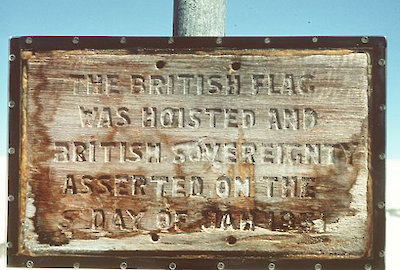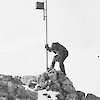Proclamation pole and plaque
Cape Denison had not been visited since the remainder of the AAE left Cape Denison in 1913. In January 1931, on the second BANZARE voyage, Mawson visited the Cape Denison site to claim formal possession of King George V Land. During the visit, five members of the AAE, including Mawson, spent a night ashore on 5–6 January 1931.
A small plaque and proclamation were affixed to the mast of the AAE anemometer station during the BANZARE territorial claim ceremony in 1931, on what was thereafter known as Proclamation Hill. The report of the expedition recorded the event thus:
At noon on 5 January the flag was hoisted on a rocky point overlooking the bay. In a casket at the foot of the pole a proclamation was deposited claiming formal possession of King George V Land defined as that section of the Antarctic coast-line between the 142nd and 160th degrees of longitude and between latitude 66 degrees south and the South Pole.
— Harold Fletcher Antarctic Days with Mawson
On June 1st [1912], Madigan and Hodgeman erected a mast to carry an instrument intended to record the maximum velocity of the wind gusts. It was constructed by Correll and others on a design which I had employed when on the B.A.E., 1907–09. It was a modification of an instrument designed by Dynes; the recording sheet was driven by clock-work and the wind force measured by tension on a metal spring.
— Douglas Mawson, AAE Scientific Reports, Series A, Vol I Narrative and Cartography.
The original proclamation was removed to Australia in 1977 and replaced with a replica in a bronze cylinder in 1978.
The original proclamation plaque, which had been removed to Australia in 1977 and returned to the site inside a transparent plastic and metal frame, was removed to Australia in 1985 and replaced with a replica in 1986.


